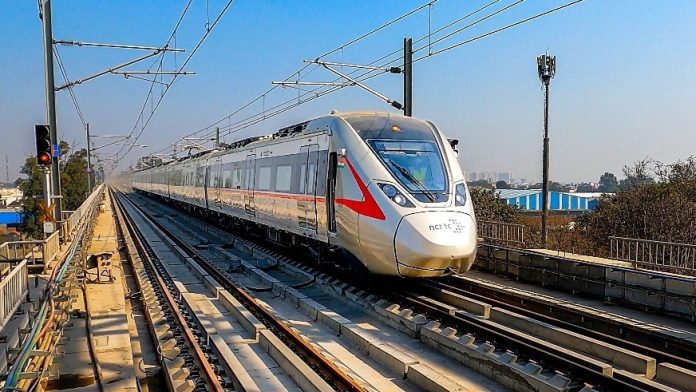NCRTC has started trial runs between Sahibabad-New Ashok Nagar section of Delhi-Ghaziabad-Meerut RRTS corridor. In this trial of RRTS, Namo Bharat train was run manually to check the compatibility of civil structure.
NCRTC has taken another important step towards preparing India’s first Regional Rapid Transit System (RRTS) and today started trial runs between Sahibabad-New Ashok Nagar section of Delhi-Ghaziabad-Meerut RRTS corridor. This is a big achievement, because Namo Bharat train is now entering Delhi, due to which the Delhi section of the corridor will be connected to the already operational Sahibabad- Meerut South section.
Namo Bharat train run manually, high speed test planned
In this trial of Regional Rapid Transit System (RRTS), Namo Bharat train was run manually to check the compatibility of civil structure. In this episode, as this test progresses, NCRTC will conduct a comprehensive evaluation to assess the integration and coordination of the train with various subsystems such as track, signaling, platform screen door (PSD) and overhead power supply system. Along with this, extensive trial runs including high-speed tests of the train are planned in the next few months.
The length of the section is 12 km, two RTS stations in Anand Vihar and New Ashok Nagar
The length of this section from Sahibabad to New Ashok Nagar is about 12 km. There are two RRTS stations in this section, Anand Vihar and New Ashok Nagar. When this section is operational, Namo Bharat Train service will be available for passengers from New Ashok Nagar to Meerut South. After which passengers will be able to reach Delhi from New Ashok Nagar to Meerut South and Meerut South to New Ashok Nagar seamlessly and at a fast speed in less than 40 minutes.
RRTS will be connected to two metro lines
Anand Vihar RRTS station will be one of the most crowded passenger transit centers on the corridor. This station is connected to two metro lines (Blue and Pink), Anand Vihar Railway Station and two ISBTs – one towards Delhi and the other towards Kaushambi in Uttar Pradesh. Due to this, a large crowd of passengers travel here on a daily basis. NCRTC is ensuring seamless integration of Anand Vihar RRTS station with these various transit modes to provide better facilities and access to the passengers, so that this station will be known as a model of multi-modal integration.
Foot Over Bridge will be constructed
New Ashok Nagar RRTS station is located less than 100 meters from New Ashok Nagar Metro Station. To integrate these two modes of transport, NCRTC is constructing a foot over bridge (FOB) to connect the concourse level of the metro station to the concourse of the RRTS station. In addition, two more FOBs are being built to facilitate access to the New Ashok Nagar RRTS station, one towards Chilla Village and Mayur Vihar Extension and the other near the ancient Shiva temple. These FOBs will provide easy access to the residents of New Ashok Nagar to commute to the station.
Also Read- IMD Weather Update: Heavy rain may occur in these states today, Read the weather updates
A total of nine stations will be included from Sahibabad to Meerut South
NCRTC has recently won top honors among various international participants at the UIC Sustainability Impact Awards 2024 in Germany. Which includes two awards, the Best Transit Award for Seamless Connectivity and the prestigious Overall Winner Award. Currently, Namo Bharat train services operate in a 42 km section from Sahibabad to Meerut South. This section includes a total of nine stations – Sahibabad, Ghaziabad, Guldhar, Duhai, Duhai Depot, Muradnagar, Modi Nagar South, Modi Nagar North and Meerut South.
These RRTS stations will be in Delhi section
With the running of Namo Bharat trains from Sahibabad to New Ashok Nagar, the length of the operational section of RRTS will increase to 54 km, which will have 11 RRTS stations. There are three RRTS stations in the Delhi section, New Ashok Nagar, Anand Vihar and Sarai Kale Khan. The section between New Ashok Nagar to Sarai Kale Khan station is in the final stages of construction and track laying activities are in progress. Once the entire 82 km corridor is operational by the targeted deadline of June 2025, passengers will be able to travel between Delhi and Meerut in less than an hour.
Related Articles:-
Mutual Fund SIP: You can make Rs 5 crore with a SIP of Rs 10,000, See formula here


